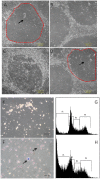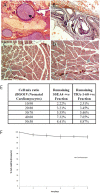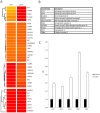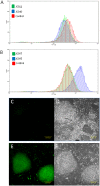A new class of pluripotent stem cell cytotoxic small molecules
- PMID: 24647085
- PMCID: PMC3960094
- DOI: 10.1371/journal.pone.0085039
A new class of pluripotent stem cell cytotoxic small molecules
Abstract
A major concern in Pluripotent Stem Cell (PSC)-derived cell replacement therapy is the risk of teratoma formation from contaminating undifferentiated cells. Removal of undifferentiated cells from differentiated cultures is an essential step before PSC-based cell therapies can be safely deployed in a clinical setting. We report a group of novel small molecules that are cytotoxic to PSCs. Our data indicates that these molecules are specific and potent in their activity allowing rapid eradication of undifferentiated cells. Experiments utilizing mixed PSC and primary human neuronal and cardiomyocyte cultures demonstrate that up to a 6-fold enrichment for specialized cells can be obtained without adversely affecting cell viability and function. Several structural variants were synthesized to identify key functional groups and to improve specificity and efficacy. Comparative microarray analysis and ensuing RNA knockdown studies revealed involvement of the PERK/ATF4/DDIT3 ER stress pathway. Surprisingly, cell death following ER stress induction was associated with a concomitant decrease in endogenous ROS levels in PSCs. Undifferentiated cells treated with these molecules preceding transplantation fail to form teratomas in SCID mice. Furthermore, these molecules remain non-toxic and non-teratogenic to zebrafish embryos suggesting that they may be safely used in vivo.
Conflict of interest statement
Figures







References
-
- Takahashi K, Tanabe K, Ohnuki M, Narita M, Ichisaka T, et al. (2007) Induction of pluripotent stem cells from adult human fibroblasts by defined factors. Cell 131 861–872. - PubMed
-
- Richards M, Fong CY, Chan WK, Wong PC, Bongso A (2002) Human feeders support prolonged undifferentiated growth of human inner cell masses and embryonic stem cells. Nature Biotechnol 20: 933–936. - PubMed
-
- Bongso A, Fong CY, Gauthaman K (2008) Taking stem cells to the clinic: Major challenges. J Cell Biochem 105: 1352–1360. - PubMed
Publication types
MeSH terms
Substances
LinkOut - more resources
Full Text Sources
Other Literature Sources
Research Materials

